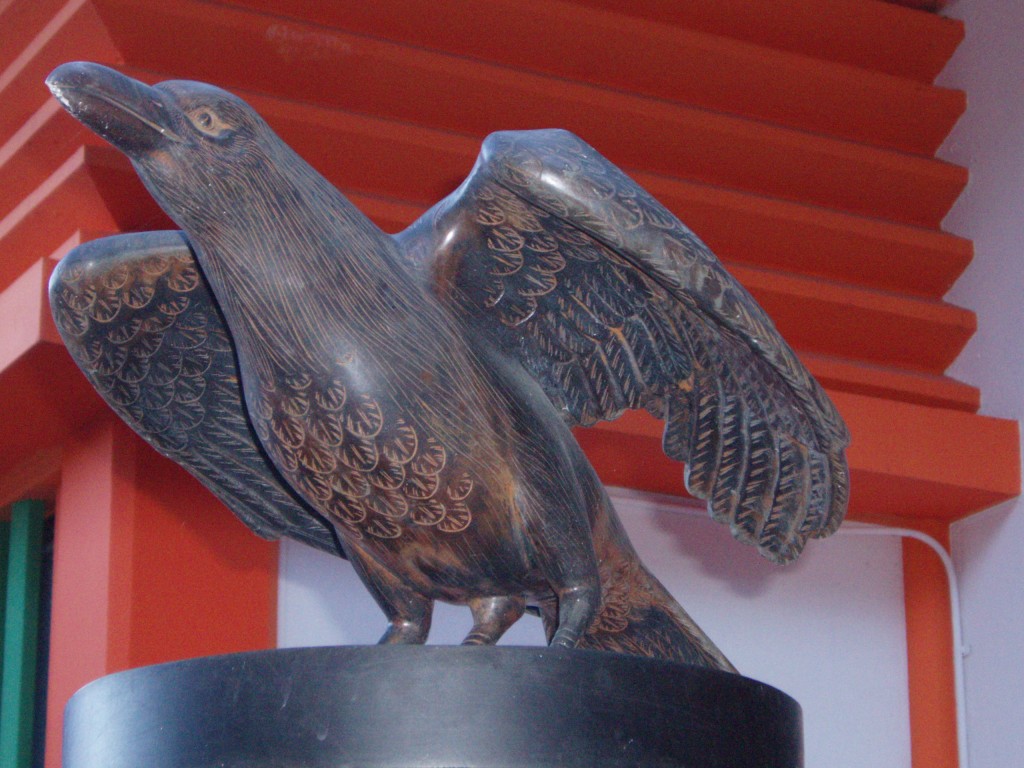
My favourite Shinto motif is yatagarasu, the three-legged crow, and not just because it’s been adopted as the mascot of the Japanese soccer team. It’s an inspiring bird of fancy that carries with it all kinds of association. It first appears in the mythology as a messenger sent by the sun goddess Amaterasu to guide Emperor Jimmu when he gets lost in hostile territory in Kumano on his way to Yamato. Writing in the Huffington Post, Katherine Marshall, senior fellow at Georgetown University, has this to say:
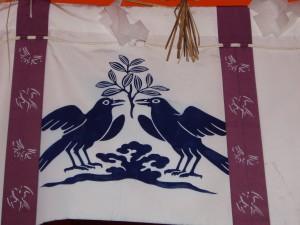
Yatagarasu noren at Kumano Hongu
“[Yatagarasu] is seen as a messenger of the gods. Why three legs? Kumano’s priests confessed that no one really knows, but told us they may represent the three ancient clans that dominated Kumano’s history. Or perhaps the three main virtues of the gods: chi (wisdom), jin (benevolence) and yuu (valor). Then again, the three legs may stand for heaven, earth and mankind. [As in the Taoist triad]
Why is the crow, often seen as an evil omen, Kumano’s symbol and protector? Legend points to the crow’s skill as a navigator, always able to find the way in unknown lands. Yatagarasu was said to have guided an emperor who had lost his way to the place. A sign at the shrine notes that the Japanese soccer association has adopted the crow as its mascot to make sure the ball finds its way into the goal. Helping those who are lost to find a path is the essence.”
http://www.huffingtonpost.com/katherine-marshall/seeking-enlightenment-fro_b_896914.html
************************
When I was in Kumano, I also asked one of the priests about the bird’s association with Amaterasu, and in reply he suggested it was to do with the black spots that appear in the sun. I asked him too about the shamanistic connections with the crow-raven of Siberian and Native American tribes, but to my surprise he said he knew nothing of that. It struck me as wilfully insular, given the widespread renown of the crow as a shamanic aide. In Siberia I remember seeing a shaman do a crow dance, and at the Kamigamo Shrine here in Kyoto the priests hop and caw like a crow at the Karasu Sumo festival in September each year. What’s that about?
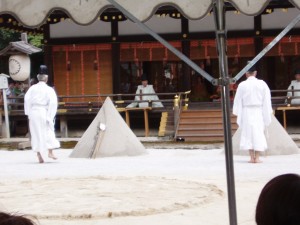
Priests hopping like crows in the Karasusumo Festival at Kamigamo Jinja
Both the Kamigamo and Shimogamo Shrines carry yatagarasu associations and proudly sell yatagarasu T-shirts and other items. Why? Well, according to their folklore yatagarasu was in fact the clan founder Kamo no Taketsunumi. It’s said the Kamo may have been an immigrant clan, in which case they could well have brought shamanism in with them from Korea. (The three-legged crow originated on the continent.) It’s an intriguing idea and makes me wonder whether in fact yatagarasu was not originally a shaman adviser to Emperor Jimmu who took cosmic flight on the wings of a crow (or even dressed in crow feathers).
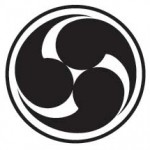
Triple tomoe
But why three legs? Well, three is a magic number in religions around the world. Shinto itself has the triple tomoe as an emblem. Father-mother-child represents the essence of life. Past-present-future is stamped into the human brain. Beginning-middle-end is the way we see things and how we make sense of the world in narrative terms. Heaven-earth-mankind was how Taoists envisaged the universe. It seems the mind has a tripartite nature, and a three-legged bird would reflect that. In addition, shamanism sees the exceptional as a mark of the divine. White snakes. Trees split by lightning. Cows with two heads. The most celebrated shaman living today in the Lake Baikal area has six fingers on one hand. A crow with three legs would be something special indeed!
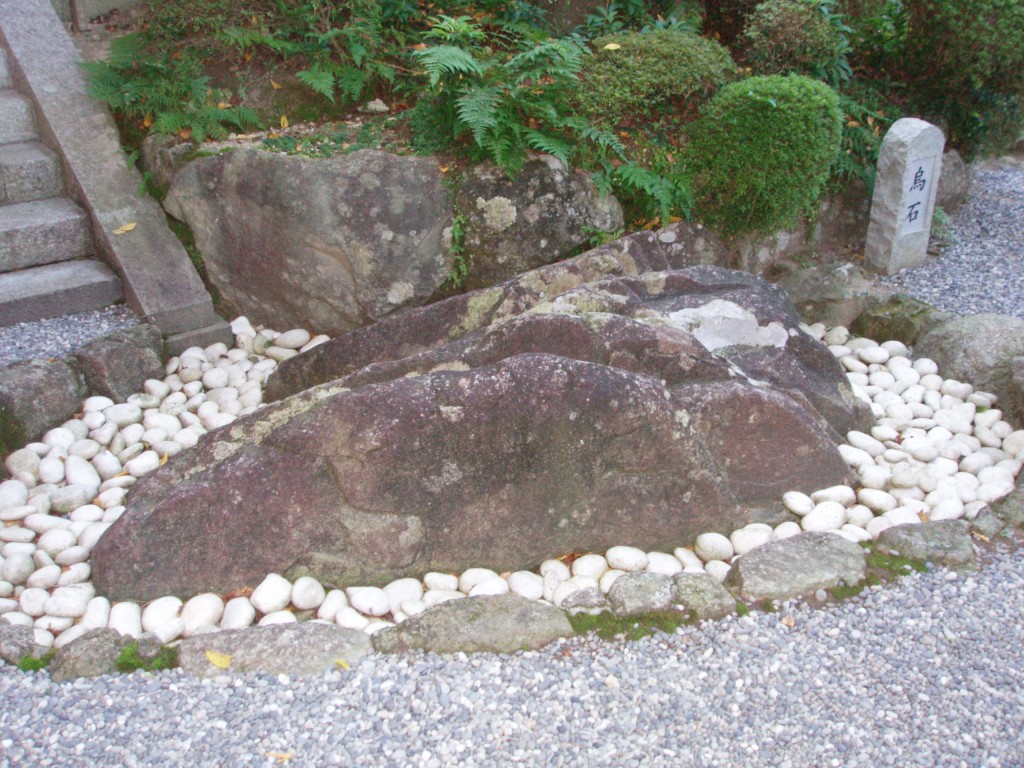
Petrified crow at Kumano Hongu, said to be where yatagarasu turned into a rock

I enjoyed this post. Yatagarasu is one of my favourite Japanese images.
Great post! I’ve often wondered about the three legged crows at Shimogamo. There’s quite a bit on three legged sun crows in Chinese, Japanese and Korean myth on this wikipedia page: http://en.wikipedia.org/wiki/Three-legged_crow
However, your suggestion that there might have been a shamanic advisor from overseas whose totem animal was the crow certainly stirs the imagination!
In Japan, Nikkō Bosatsu is associated with a black three-legged crow, as are other deities including Myōken (the deification of the Pole Star and the Big Dipper), Emperor Jimmu 神武天皇 (Japan’s legendary first emperor), and Nōjo Taishi 能除太子 (the founder of Haguro Shugendō). People with eye disease or poor eye sight in Japan can purchase talismans or icons called Nissei Manishu 日精摩尼手, which show the 3-legged bird inside the sun disc. Making proper pleas and prayers to the icon is said to cure one’s eye problems. Let us recall that Myōken literally means “wonderous sight.”
Why the three legs and why the black crow inside a sun disk? The most plausible reasons involve Chinese mythology and Japan’s own creation legends. First, a black three-legged crow known in China as Sānzúwū 三足烏 (lit. = three-legged bird) appears in Chinese artwork dated to the Yǎngsháo 仰韶 period (5000 BC to 3000 BC). In Chinese mythology and ancient philosophical texts, this bird is intimately related to the sun. It has three legs, according to the Huáinánzǐ 淮南子(2nd century BC Chinese text), because three is the emblem of Yang — and the supreme essence of Yang is the sun.
Second, in Japan’s own creation myths, including the Nihon Shoki 日本書紀 (submitted to the Japanese imperial court in 720 AD), a giant crow called Yata-garasu 八咫烏 (eight-span crow) appeared to Japan’s first emperor, Jimmu 神武天皇, who had landed on the shores of Japan but gotten lost. The crow was sent by Amaterasu Ōmikami 天照大神 (Japan’s supreme sun goddess) to lead Jimmu to Yamato (the heartland of Japan). Says site contributor Cate Kodo Juno, an ordained Buddhist priest of Japan’s Shingon sect: “Since the crow is also associated with Myōken and the Pole Star, could it be that it was the Pole Star that guided Jimmu?”
Third, according to Maison Franco-Japonaise (which translated the film Shugen: The Autumn Peak of Haguro Shugendō): “The founder of Haguro Shugendō is Nōjo Taishi 能除太子, who is said to have come to Haguro early in the seventh century. He was given the title of Shōken Daibosatsu 照見大菩薩 in the 19th century. Legend says he was the third son of the late sixth century emperor Sushun 崇峻天皇 (reigned 587 to 592), and the cousin of Shōtoku Taishi (574-622), Japan’s first great patron of Buddhism. According to legend, prince Nōjo renounced his title and position, took the name Kōkai 弘海, and became a wandering hermit of the mountains. Nōjo is depicted as a strange being, dark of skin and with exaggerated facial features, his mouth extending from ear to ear. It was to a place called Akoya, in a narrow valley full of thick growth, with a waterfall at one end, that Nōjo was guided by a mystical three-legged crow, and it was here that he first did ascetic training. Here also he found a statue of Kannon Bosatsu and it was from here that he founded the three sacred mountains (Dewa Sanzan) as a Shugendō site.” Site contributor Cate Kodo Juno offers another asute observation: “It is most likely that the story of Haguro Shugendō founder Nōjo Taishi is emulating the story of Emperor Jimmu, as often happens in hagiographies, in order to provide added legitimacy and authority to Nōjo’s legend.”
Some final words on the above Shugendō legend. Today people equate the three-legged bird with the three sacred mountains of Dewa Sanzan, but the basis of the legend goes back to earlier Chinese mythology. Also, Myōken, the deification of the Pole Star and Big Dipper, is a major star deity at sacred Mt. Haguro, one who is said to possess the power to cure eye diseases.
Above quoted from my page at:
http://www.onmarkproductions.com/html/nikko-gakko.shtml
Hi Mark and many thanks for that valuable information. A great endorsement for your wonderful website.
From what I’ve learnt recently, the mythological sun-crow crops up in several other countries besides China, so I’m inclined to look for the roots on the continent. The yang idea is certainly an interesting lead… there’s also the idea of three being a magical number and of shamanism favouring the physically unusual or unique. All in all, I think we can agree the yatagarasu is a most potent symbol!